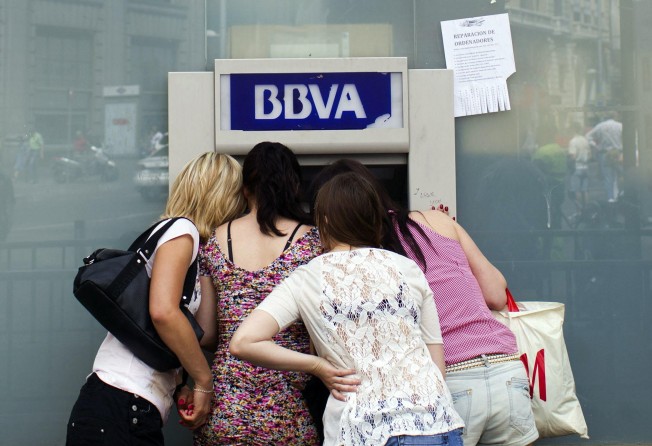
No pain, no gain for Spain
Overwhelmed by recession since 2008, Spain's economy seems to have turned a corner but faces an anti-austerity backlash that could set it back

Spain is starting to win plaudits. Two years after a near sovereign default, the crisis weary economy seems to have turned the corner. The financial bailout is officially over and investors are returning to Spain's financial markets.

The government is still clearing up the mess caused by the collapse of Spain's property bubble in 2008.
Spain has been overwhelmed by recession for five out of the last six years. Consumers are bearing the brunt of heavy economic reconstruction costs. Unemployment has skyrocketed. Living standards have plummeted for those hardest hit by the crisis.
Slow recovery guarantees the deficit continues to widen without tougher austerity policies
But there are some tentative signs of recovery. Spain's economy has just edged back into positive growth territory, following twin recessions in 2008-2009 and 2011-2013. Gross domestic product expanded by 0.2 per cent in the fourth quarter last year, its second successive period of expansion.
Spain's industrial sector is staging a comeback. Industrial production rose at its fastest pace in more than three years in February, with output up 2.8 percentage points from a year earlier. Business optimism has perked up. In March, Spanish manufacturing activity expanded at its fastest rate in four years, while the services sector grew for its fifth successive month. This followed a long period of business contraction.
The government has been encouraged. So much so that it upgraded its outlook for GDP growth this year to 1 per cent, after a 1.2 per cent output drop last year.
In January, the government even formally exited the programme entered into in 2012 in exchange for a €41.3 billion (HK$442 billion) loan from its European partners to clean up its distressed banking system.
The improved economic outlook has been a shot in the arm for Spain's financial markets. Spain's credit ratings have improved. International investors are returning to place constructive bets on Spanish stock, debt and property markets again.
Two years on, from teetering on the edge of default, Spain's sovereign borrowing costs have fallen to record lows, thanks to Spanish debt being in high demand from investors hungry for higher yielding assets.
The key question is whether these flows are being driven by buy-and-hold investors, or the product of more capricious hot money flows that could easily turn sour again if the outlook takes a turn for the worse.
Spain is not out of the woods by any stretch of the imagination. The economy is still facing very severe problems.
There is a very large black hole in Spain's economy. Domestic demand has imploded in the last six years. Government austerity cuts and private sector deleveraging are all to blame.
Consumer spending power collapsed thanks to the surge in unemployment, the sharp squeeze on disposable income and negative wealth effects from the slump in house prices. Tax rates have risen, welfare spending has fallen and wages have been under severe pressure.
Tight credit conditions are not helping matters either. In February, bank lending to the personal sector was down 5 per cent from a year earlier, with consumer credit dropping 7.2 per cent year on year.
With the ECB due to launch the next round of stress tests on euro-zone banks, capital adequacy requirements on Spanish banks could get even tougher. Loan conditions for Spain's hard-pressed borrowers could tighten even more. If so, it will not be good news for recovery.
The government is still pumping in public money to prop up Spain's ailing banking sector. And it is still coming to the aid of other key sectors of the economy in need of rescue, like construction and transport infrastructure.
This is not helping the process of getting the government's badly damaged budget finances into better repair.
The government is struggling to meet its austerity targets, critically missing its budget deficit reduction target last year. Slow recovery almost guarantees the deficit continues to widen without tougher austerity policies being implemented - meaning higher taxes and bigger spending cuts are looming.
Spain has pledged to reduce its public sector shortfall to 3 per cent of GDP by 2016. The government will need to find an extra €35 billion to €40 billion in savings in the next three years. On present trends it looks like a bridge too far.
In the meantime, Spain's mountain of public sector debt continues to spiral higher. Before the crisis, it had one of the lowest debt to GDP ratios in the euro zone, around 60 per cent. By next year, Spain's debt could come close to 110 per cent of GDP.
It could be many years before fuller employment returns to Spain. At least one in four workers remain out of work. Youth unemployment is as high as 50 per cent. The seeds for social unrest are rife. Patience is running thin. Support for Spain's centre-right government is on the slide. Anti-austerity protests are on the rise.
If the market scents even a whiff of a U-turn, that hot money flow will hit the exits very quickly. And Spain will feel the pain again.
David Brown is the chief executive of New View Economics